Bathtub
How to Install Alcove Bathtub
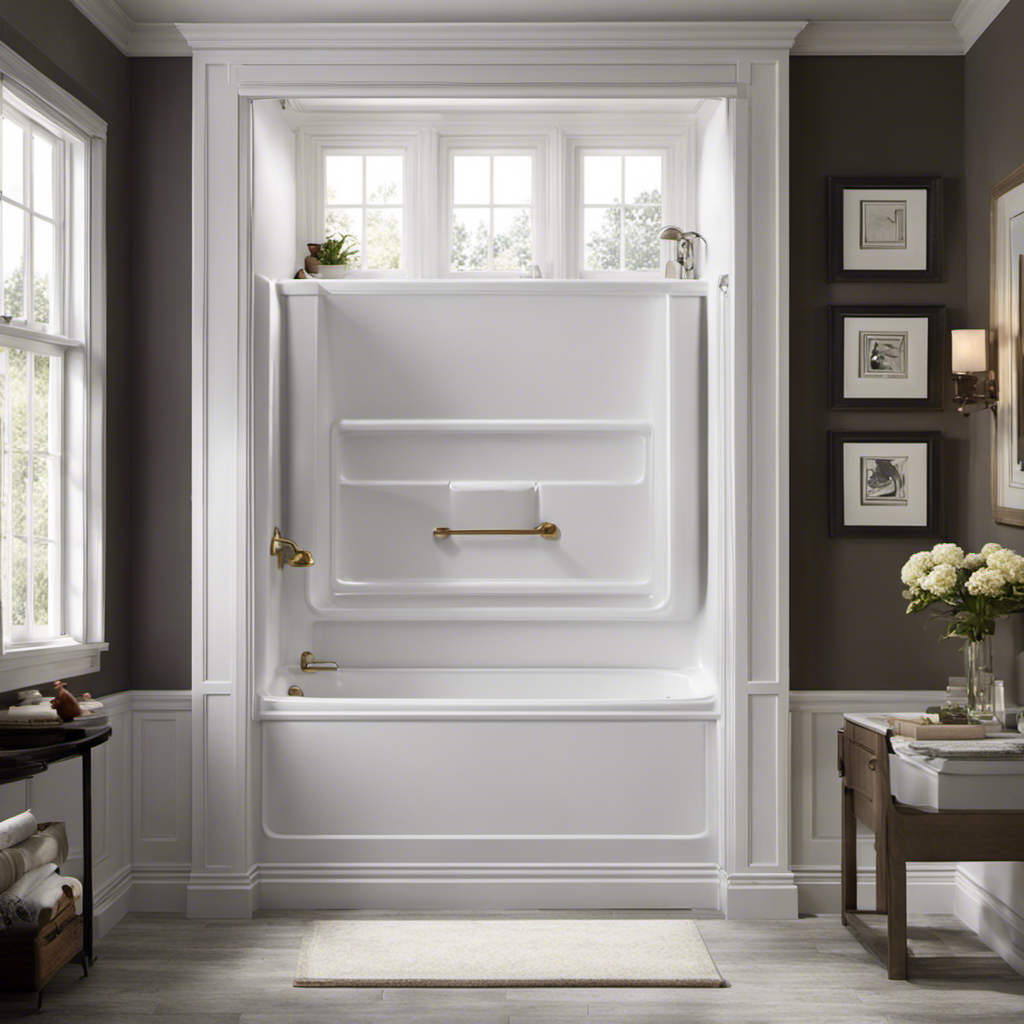
I’m here to show you how to install an alcove bathtub, step-by-step.
Picture transforming your bathroom into a tranquil oasis, where you can soak away the stresses of the day.
With the right tools and materials, you’ll be able to tackle this project with confidence.
We’ll cover everything from preparing the alcove area to sealing and waterproofing the bathtub.
Let’s dive in and make your dream bathroom a reality.
Key Takeaways
- Properly measure the alcove area and account for any obstructions before installing the alcove bathtub.
- Disconnect plumbing connections and remove old fixtures carefully to avoid damage or accidents.
- Ensure proper plumbing and drainage connections are made before installing the alcove bathtub.
- Use high-quality waterproofing materials and proper sealing techniques to prevent water leakage and protect against mold and mildew growth.
Necessary Tools and Materials
To install an alcove bathtub, you’ll need a set of necessary tools and materials.
First, gather your tools: a tape measure, level, adjustable wrench, screwdriver, utility knife, and caulking gun.
For materials, you’ll need the alcove bathtub, waterproofing membrane, cement backer board, construction adhesive, screws, silicone caulk, and a drain assembly.
Before starting the installation process, it is important to ensure that the area is properly waterproofed. Apply a waterproofing membrane to the walls and floor of the alcove area, following the manufacturer’s instructions. This will help prevent any water damage to the surrounding walls.
Once the waterproofing is done, you can move on to preparing the alcove area for the installation of the bathtub.
Preparing the Alcove Area
First, I need to measure the alcove area to ensure that the new bathtub will fit properly. I will measure the length, width, and height of the alcove, taking into account any obstructions such as pipes or electrical outlets.
Once I have the measurements, I can begin removing the old fixtures, such as the old bathtub and showerhead. I will turn off the water supply and disconnect any plumbing connections before carefully removing the fixtures.
Measuring the Alcove
Now, you’re going to need to measure the width and height of the alcove for your new bathtub. To ensure measuring accuracy and proper fit, follow these steps:
- Start by using a tape measure to measure the width of the alcove from wall to wall. Measure at the top, middle, and bottom to account for any variations.
- Next, measure the height of the alcove from the floor to the top of the wall. Again, measure at multiple points to ensure accuracy.
Take note of any obstructions or protrusions in the alcove, such as pipes or electrical outlets. These will need to be considered when selecting a bathtub.
Double-check your measurements to ensure accuracy. If there are any discrepancies, remeasure to be certain.
Record the alcove dimensions, taking note of the smallest measurements. This will help you choose a bathtub that fits perfectly.
Removing Old Fixtures
When removing the old fixtures, make sure to turn off the water supply and disconnect any plumbing connections. This step is crucial to ensure a smooth and hassle-free bathtub removal process. Start by locating the water shut-off valve and turning it clockwise until it’s fully closed. This will prevent any water from flowing into the fixtures while you work. Next, disconnect the plumbing connections using a wrench or pliers, depending on the type of fixtures you have. Once the water supply is turned off and the plumbing connections are disconnected, you can proceed to remove the bathtub. It’s important to follow these steps carefully to avoid any potential damage or accidents during the process.
| Tools Needed | Safety Precautions |
|---|---|
| Wrench | Wear protective goggles |
| Pliers | Use gloves to protect hands |
| Screwdriver | Ensure proper ventilation |
Now that the old fixtures have been removed, it’s time to shift our focus to ensuring proper drainage.
Ensuring Proper Drainage
To ensure proper drainage, it’s important to check for any clogs or blockages in the plumbing pipes. Here’s a step-by-step guide to help you ensure proper drainage for your alcove bathtub:
-
Check the drainage slope: Make sure that the floor under the bathtub has a slight slope towards the drain. This will allow the water to flow easily and prevent any standing water.
-
Inspect the plumbing pipes: Look for any clogs or blockages in the pipes leading to the drain. Use a plumber’s snake or a drain cleaner to remove any debris that may be causing the blockage.
-
Install a waterproofing membrane: Apply a waterproofing membrane to the walls and floor around the alcove bathtub. This will prevent any water from seeping into the walls and causing damage.
-
Test the drainage: Fill the bathtub with water and let it drain. Check for any leaks or slow drainage. If you notice any issues, address them before proceeding with the installation.
-
Regular maintenance: Once the alcove bathtub is installed, make sure to regularly clean the drain and check for any clogs to ensure continued proper drainage.
Plumbing and Drainage
First, make sure you’ve properly connected the plumbing and drainage system before installing the alcove bathtub. This step is crucial to ensure that the water flows smoothly and there are no leaks.
To start, gather all the necessary plumbing materials such as pipes, connectors, and a drain assembly. Measure and mark the locations where the pipes will be installed, ensuring they align with the bathtub’s drain and faucet openings. Use a pipe cutter to cut the necessary lengths of pipe, and attach them using the appropriate connectors. Secure all connections tightly to prevent any leaks.
Once the plumbing installation is complete, proceed with choosing the right bathtub that suits your preferences and fits well in your bathroom space. Take accurate measurements and select a bathtub that matches your desired style and functionality.
Installing the Bathtub
Once you’ve properly connected the plumbing and drainage system, it’s important to choose a bathtub that fits well in your bathroom space. To ensure a successful bathtub installation, here are some tips to consider:
-
Measure the alcove area: Take accurate measurements of the alcove where the bathtub will be installed. Consider the length, width, and height to find a bathtub that fits perfectly.
-
Select the right material: Choose a bathtub made from durable materials like acrylic or fiberglass. These materials are easy to clean and maintain.
-
Consider the style: Decide on the style of the alcove bathtub that matches your bathroom’s overall design. Options include traditional, modern, or contemporary styles.
-
Look for additional features: Consider features like built-in shelves, armrests, or whirlpool jets to enhance your bathing experience.
-
Check installation requirements: Ensure that the chosen alcove bathtub meets all the installation requirements, including proper support and access for plumbing connections.
Sealing and Waterproofing
When it comes to sealing and waterproofing, it’s important to use the best materials to ensure long-lasting results. In this discussion, I will share the top waterproofing materials that are highly recommended for their effectiveness.
Additionally, I will discuss sealing techniques that can help prolong the lifespan of your seals, as well as common sealing mistakes to avoid.
Best Waterproofing Materials
For best results, it’s important to use high-quality waterproofing materials when installing an alcove bathtub. Proper waterproofing techniques not only protect your bathroom from water damage but also extend the longevity of your bathtub. Here are some benefits of waterproofing and the best materials to achieve them:
- Prevents water leakage and seepage into the walls and floors
- Protects against mold and mildew growth
- Increases the lifespan of your alcove bathtub
- Provides a clean and finished look to your bathroom
- Enhances the overall value of your home
To ensure effective waterproofing, use materials like waterproof membranes, sealants, and grouts. These products create a barrier that prevents water from penetrating the walls and floor. Apply the waterproofing materials according to the manufacturer’s instructions, paying special attention to corners, joints, and seams. This will create a watertight seal that safeguards your bathroom and alcove bathtub from water damage.
Now let’s move on to the next section where we’ll discuss sealing techniques for longevity.
Sealing Techniques for Longevity
To increase the lifespan of your bathroom, it’s essential to properly seal all corners, joints, and seams using recommended techniques. Waterproofing techniques play a crucial role in preventing water damage and mold growth, ensuring the longevity of your bathroom.
Here are the steps to achieve a proper seal:
-
Clean the surface: Remove any dirt, dust, or debris from the corners, joints, and seams using a mild detergent and water solution. Allow it to dry completely before proceeding.
-
Apply a waterproofing membrane: Use a waterproofing membrane specifically designed for bathrooms. Cut it to size and apply it to the corners, joints, and seams, making sure to overlap the membrane on all sides.
-
Seal with silicone caulk: Apply a bead of silicone caulk along the edges of the corners, joints, and seams. Smooth it out with a caulk tool or your finger to ensure a tight seal.
-
Let it cure: Allow the silicone caulk to cure according to the manufacturer’s instructions before exposing it to water.
By following these waterproofing techniques and achieving a proper seal, you can ensure the longevity of your bathroom and prevent costly water damage.
Now, let’s discuss some common sealing mistakes to avoid.
Common Sealing Mistakes
Make sure you don’t forget to inspect the corners, joints, and seams for any cracks or gaps, as this is a common sealing mistake. Properly sealing your alcove bathtub is crucial to prevent water damage and ensure its longevity.
Here are some common sealing mistakes to avoid:
- Not cleaning the surface properly before applying sealant.
- Using the wrong type of sealant for the material of your bathtub.
- Applying too much or too little sealant.
- Neglecting to apply sealant to all areas, including the corners and edges.
- Not allowing the sealant to cure properly before using the bathtub.
To avoid these mistakes, it is important to choose the right sealant for your alcove bathtub. Consider factors such as the material of your bathtub, the level of water exposure, and any specific instructions from the manufacturer. Additionally, follow the instructions provided with the sealant and allow enough time for it to fully cure before using the bathtub.
Finishing Touches and Clean-up
Once you’ve finished installing the alcove bathtub, don’t forget to wipe down the surrounding area and remove any excess caulk or debris. This step is crucial to ensure a clean and polished finish.
Start by gathering your cleaning products, such as a mild soap or bathroom cleaner, a sponge, and a clean cloth.
Begin by wiping down the surfaces around the bathtub, including the walls and floor. Pay special attention to any areas where caulk or debris may have accumulated. Use the sponge and cleaning solution to scrub away any dirt or grime.
Once you’re satisfied with the cleanliness, rinse the area thoroughly with water and dry it with a clean cloth.
This final step in bathtub maintenance will leave your newly installed alcove bathtub looking pristine and ready for use.
Conclusion
In conclusion, installing an alcove bathtub is a detailed process that requires careful preparation and attention to detail. By following the step-by-step instructions and using the necessary tools and materials, you can successfully complete this project.
Remember to take your time and ensure proper plumbing and drainage, as well as sealing and waterproofing, to prevent any future issues.
With a little effort and patience, you’ll soon be enjoying a relaxing soak in your new alcove bathtub, making all your stress melt away like bubbles in a hot bath.
Liam’s journey with us started as a consumer. Having faced challenges while setting up his own modern bathroom, he delved deep into research.
Recognizing his knack for simplifying complex information and his authentic writing style, we were thrilled to welcome him aboard. Liam’s articles often merge practicality with style, ensuring readers find the perfect fit for their homes. Liam is an avid hiker off-duty and often jokes about finding the best “natural toilets” Mother Earth has to offer.
Bathtub
What Makes a Toilet Less Likely to Clog

Here is what we have discovered about preventing clogged toilets:
- A good flush is key. By using proper flushing techniques, we can prevent blockages and ensure smooth operation.
- Toilet paper usage is another factor to consider. Being mindful of how much we use can make a big difference.
- Regular maintenance and cleaning also play a crucial role in preventing clogs.
- Moreover, if we avoid flushing non-flushable items and consider upgrading to a high-pressure toilet, we can further reduce the risk of clogging.
Key Takeaways
- Use the appropriate amount of water to flush waste effectively.
- Avoid flushing non-flushable items such as baby wipes, dental floss, and cotton swabs.
- Regular maintenance and cleaning of the toilet bowl, drain, and tank are essential to prevent clogs.
- Consider upgrading to a high-pressure toilet for improved flushing power and reduced likelihood of clogs.
Proper Flushing Techniques
To ensure a toilet is less likely to clog, we must use the proper flushing techniques. Water conservation during flushing plays a crucial role in preventing clogs. It’s essential to use the appropriate amount of water to flush away waste effectively without wasting excess water.
When flushing, a high water pressure is necessary to ensure efficient removal of waste from the toilet bowl. Adequate water pressure creates a strong force that helps carry away debris and prevents it from getting stuck in the drainage system. However, excessively high water pressure may lead to splashing or overflowing, which can cause clogs.
Therefore, it’s important to strike a balance between water pressure and conservation to maximize flushing efficiency while minimizing the risk of clogs.
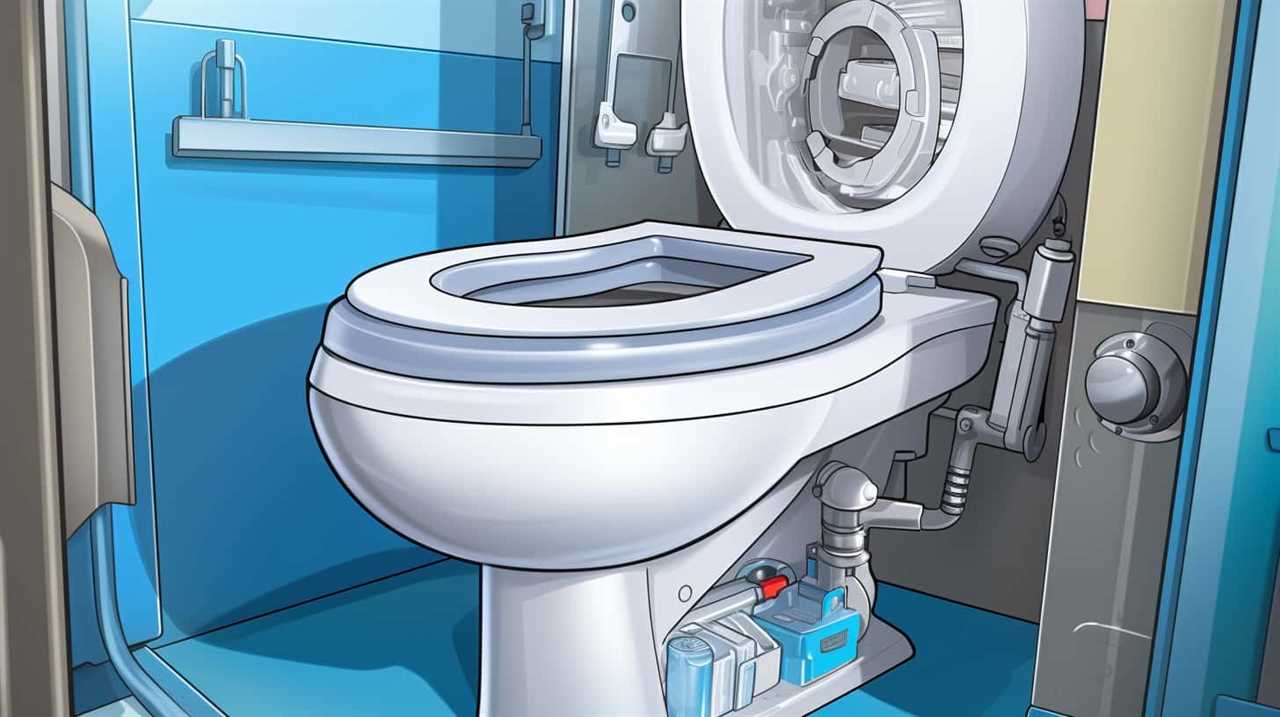
Toilet Paper Usage
When it comes to preventing clogs, our toilet paper usage is a crucial factor to consider. Not all toilet papers are created equal, and some are more prone to causing blockages than others. To help you make an informed choice, let’s analyze the environmental impact and explore alternatives to traditional toilet paper.
Toilet paper usage can have a significant environmental impact. The production of toilet paper involves cutting down trees and requires a substantial amount of water and energy. Additionally, the transportation and disposal of toilet paper contribute to carbon emissions and waste accumulation.
Considering alternatives to toilet paper can help reduce the environmental impact. Bidets, for example, provide a more hygienic and efficient way to clean oneself after using the toilet. Other options include reusable cloth wipes or bamboo-based toilet paper, which is more sustainable than traditional options.
By understanding the environmental impact of our toilet paper usage and exploring alternatives, we can make more conscious choices that are both eco-friendly and effective in preventing clogs.

Now, let’s delve into the next section about regular maintenance and cleaning.
Regular Maintenance and Cleaning
Maintaining and cleaning our toilets regularly is essential in preventing clogs and ensuring optimal performance. Neglecting this aspect of toilet care can lead to unpleasant and costly issues down the line. To keep our toilets in top shape, here are some important steps to follow:
- Toilet bowl scrubbing: Regularly scrubbing the toilet bowl removes built-up grime and prevents blockages. Use a toilet brush and a mild cleaner to thoroughly clean the bowl, paying special attention to the rim and under the rim.
- Drain inspection: Periodically inspecting the drain can help identify potential clogging issues before they become major problems. Check for any signs of blockage, such as slow draining or unusual noises. If necessary, use a plunger or a drain snake to clear any debris.
- Cleaning the tank: It’s also important to clean the toilet tank to prevent sediment buildup. Remove the tank lid and use a sponge or brush to clean the inside surfaces. Be sure to flush the tank thoroughly after cleaning.
- Regular maintenance schedule: Establish a regular maintenance schedule to ensure that cleaning and inspection tasks are performed consistently. This will help prevent clogs and maintain optimal toilet performance.
Avoiding Flushing Non-Flushable Items
One important step in preventing toilet clogs is to avoid flushing non-flushable items. Properly disposing waste and educating children about what can be flushed are crucial aspects of maintaining a functional toilet system. To emphasize the significance of this step, let’s take a look at the following table:
| Non-Flushable Items | Why They Shouldn’t Be Flushed | Proper Disposal Method |
|---|---|---|
| Baby wipes | They do not break down easily | Dispose in the trash |
| Dental floss | Can cause clogs and tangles | Throw in the trash |
| Cotton swabs | Can get stuck and form blockages | Dispose in the trash |
Disposing waste properly involves recognizing that some items, such as baby wipes, dental floss, and cotton swabs, should not be flushed down the toilet. Instead, they should be placed in the trash. Educating children about these guidelines is essential to prevent accidental flushing of non-flushable items. By following these practices, we can reduce the risk of toilet clogs and maintain a properly functioning toilet system.
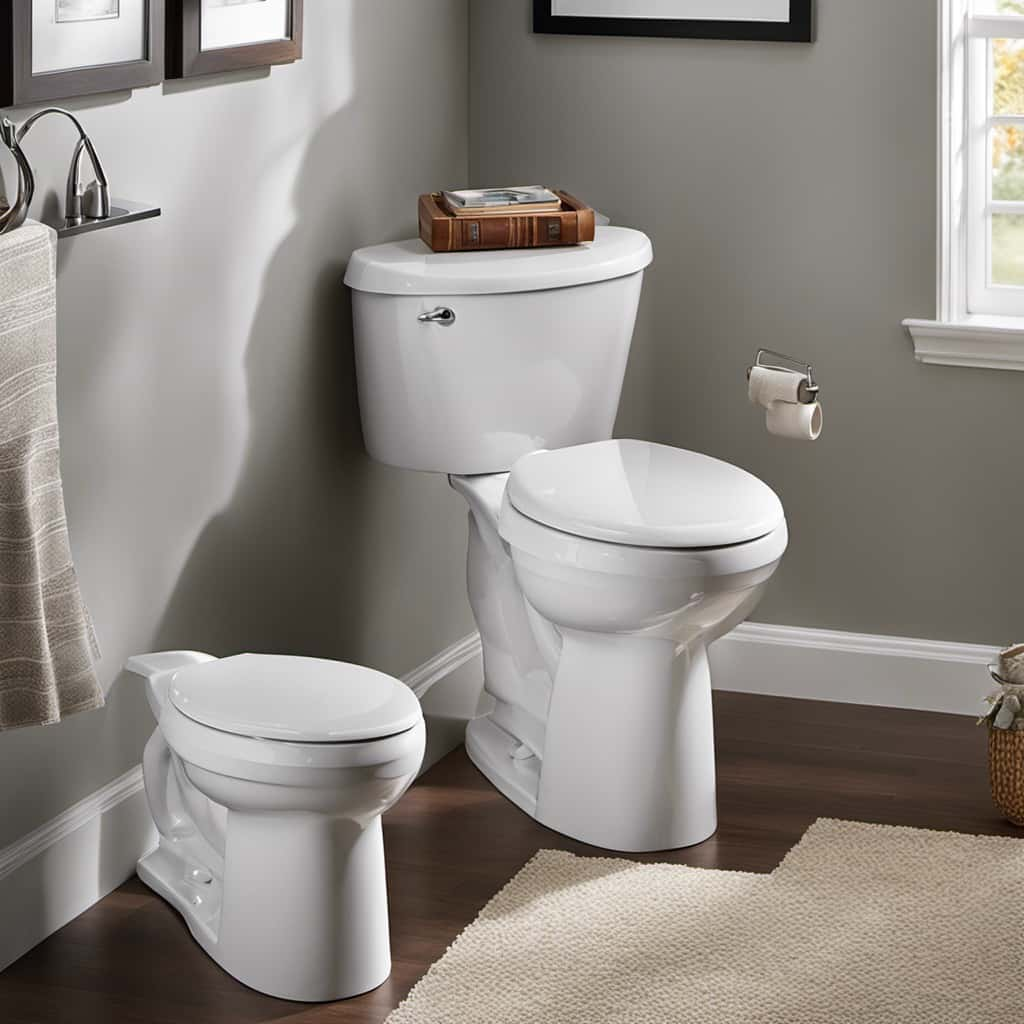
Upgrading to a High-Pressure Toilet
To reduce the likelihood of clogs, we recommend upgrading to a high-pressure toilet. High-pressure toilets are designed to provide a stronger flush, which helps to clear waste more effectively and prevent clogs from occurring.
Here are some key benefits of upgrading to a high-pressure toilet:
- Increased water pressure: High-pressure toilets are designed to operate with higher water pressure, ensuring a more forceful and thorough flush.
- Efficient waste removal: The increased water pressure helps to push waste through the plumbing system more efficiently, reducing the chances of clogs.
- Less maintenance: With a high-pressure toilet, you’ll experience fewer clogs, which means less time and money spent on maintenance and repairs.
- Improved overall performance: Upgrading to a high-pressure toilet will enhance the overall performance of your plumbing system, ensuring a more reliable and efficient flushing experience.
Frequently Asked Questions
How Do I Fix a Clogged Toilet if the Proper Flushing Techniques Mentioned in the Article Don’t Work?
If the proper flushing techniques don’t work to fix a clogged toilet, we can try other toilet unclogging techniques. One effective method is using a plunger to create suction and dislodge the blockage.
Can Using a Bidet Instead of Toilet Paper Help Prevent Clogs?
Using a bidet instead of toilet paper has several benefits, including reducing the environmental impact of toilet paper. Bidets use water to clean, which can help prevent clogs by ensuring proper flushing.

How Often Should I Hire a Professional Plumber for Regular Maintenance and Cleaning of My Toilet?
For regular maintenance and cleaning of our toilet, we should hire a professional plumber periodically. They are skilled in identifying and resolving potential issues, ensuring optimal functionality and reducing the likelihood of clogs.
What Are the Consequences of Flushing Non-Flushable Items, and How Can They Be Avoided?
Flushing non-flushable items can have serious consequences, such as clogs and damage to your plumbing system. To avoid these issues, it is crucial to educate ourselves on what can and cannot be flushed and dispose of non-flushable items properly.
Are There Any Drawbacks or Disadvantages to Upgrading to a High-Pressure Toilet?
When considering the advantages and disadvantages of upgrading to a high-pressure toilet, it is important to evaluate factors such as water consumption, noise levels, and maintenance requirements.
Conclusion
In conclusion, after investigating the truth behind what makes a toilet less likely to clog, it’s clear that proper flushing techniques, mindful toilet paper usage, regular maintenance and cleaning, avoiding flushing non-flushable items, and upgrading to a high-pressure toilet are all essential factors.

By following these guidelines, you can ensure a smoothly functioning toilet and minimize the chances of experiencing clogs. Remember, a little attention and care go a long way in maintaining a trouble-free bathroom experience.
With an impeccable eye for detail and a passion for bathroom-related, Ava leads our editorial team gracefully and precisely.
Under her guidance, Best Modern Toilet has flourished as the go-to resource for modern bathroom enthusiasts. In her free time, you might find Ava exploring antique shops and looking for vintage bathroom fixtures to add to her collection.
Bathtub
Is It Ok to Flush Condoms Down the Toilet

Let’s discuss a crucial topic: the correct way to dispose of condoms.
Flushing condoms down the toilet may seem convenient, but is it really okay? In this article, we’ll explore the potential risks and environmental impact of this practice.
We’ll also discuss the effects on plumbing systems and provide responsible alternatives for condom disposal.
Join us as we delve into this topic, aiming to inform and empower you with the knowledge you need for responsible condom use.
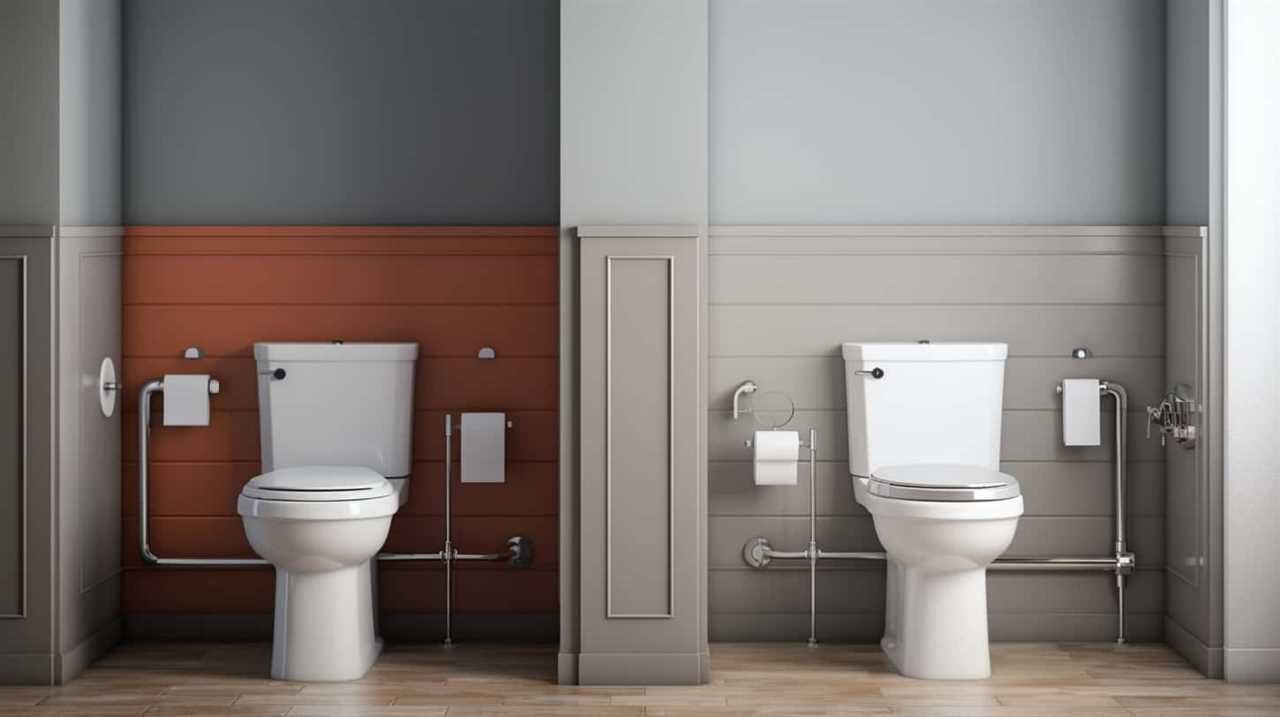
Key Takeaways
- Flushing condoms can lead to clogs and costly repairs in sewage systems.
- Flushed condoms contribute to environmental pollution in water bodies and harm marine life.
- Condoms made of latex or polyurethane are not easily biodegradable and can cause plumbing issues.
- Responsible disposal methods, such as wrapping condoms in tissue and throwing them in the trash, are essential for preventing these risks.
Potential Risks of Flushing Condoms
Flushing condoms down the toilet poses several potential risks that we should be aware of.
One of the main risks is the possibility of clogging the sewage system. Condoms are made of materials that don’t easily break down in water, such as latex or polyurethane. As a result, when flushed down the toilet, they can cause blockages in pipes and sewage treatment plants. These blockages not only disrupt the flow of wastewater, but they can also lead to costly repairs and maintenance.
Moreover, the impact on sewage systems goes beyond clogging. Condoms can end up in rivers, lakes, and oceans, contributing to environmental pollution. It’s important to properly dispose of condoms in designated waste bins to avoid these risks and protect the integrity of sewage systems.
Environmental Impact of Flushing Condoms
When condoms are flushed down the toilet, they contribute to environmental pollution by ending up in rivers, lakes, and oceans. This has significant biodegradability concerns and can have a detrimental impact on aquatic ecosystems. The materials used in condoms, such as latex and polyurethane, are not readily biodegradable and can persist in the environment for a long time. As a result, these non-biodegradable condoms can accumulate in water bodies, posing a threat to marine life. To illustrate the gravity of this issue, consider the following table:
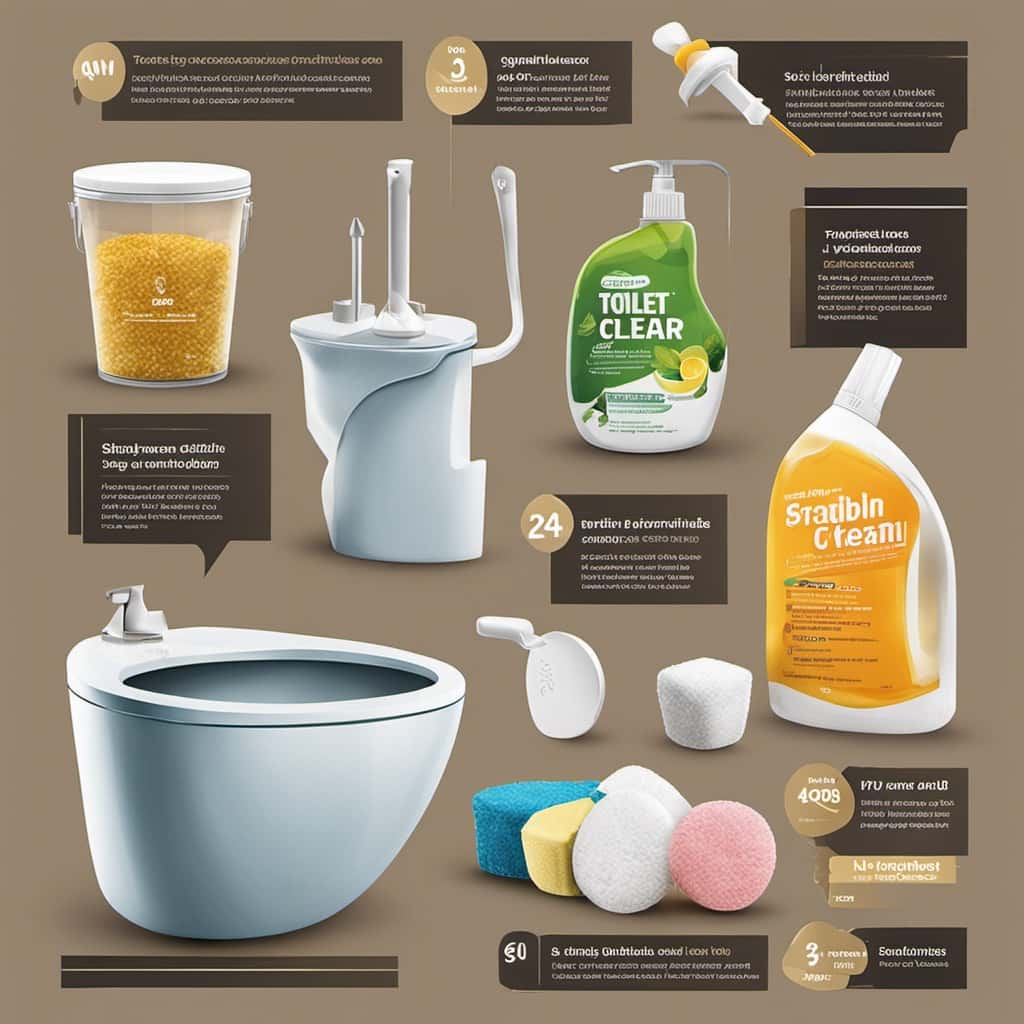
| Environmental Impact of Flushing Condoms | ||
|---|---|---|
| Condom Materials | Biodegradability | Impact on Aquatic Ecosystems |
| Latex | Not readily biodegradable | Can harm marine life |
| Polyurethane | Not readily biodegradable | Can harm marine life |
It is crucial to raise awareness about the negative consequences of flushing condoms and encourage responsible disposal methods to protect our environment.
Effects of Condoms on Plumbing Systems
As we continue our discussion on the environmental impact of flushing condoms, it’s important to consider the effects these contraceptives can have on plumbing systems.
When condoms are flushed down the toilet, they can cause various plumbing issues that may lead to clogging concerns. Condoms are made of materials like latex or polyurethane, which aren’t easily biodegradable. These materials have the potential to cause blockages in pipes, especially in older plumbing systems with narrower pipes.
Additionally, condoms can wrap around other debris in the plumbing, creating a larger obstruction. This can result in reduced water flow, backups, and even costly repairs.
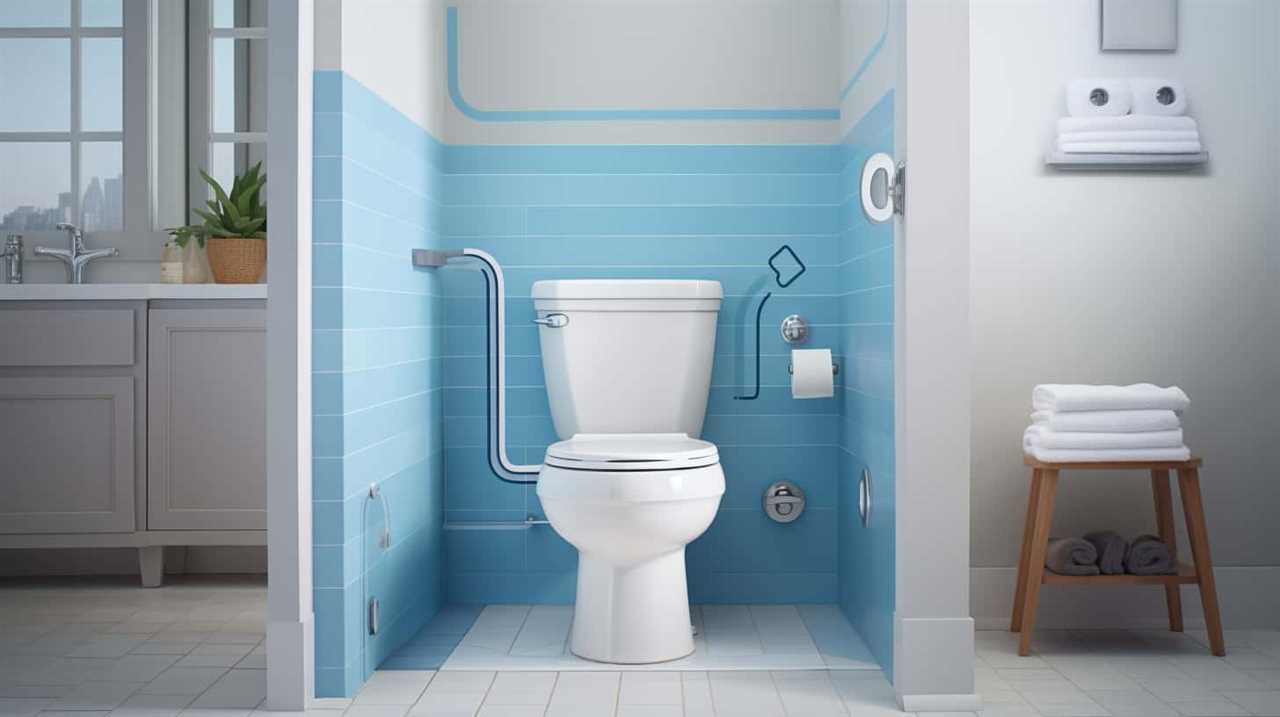
It’s crucial to dispose of condoms properly in trash bins to prevent these plumbing problems and maintain the integrity of the plumbing system.
Alternatives to Flushing Condoms
To avoid the potential plumbing issues associated with flushing condoms, we can explore alternative methods of disposal.
One sustainable condom disposal option is to wrap the used condom in tissue or toilet paper and place it in a waste bin. This prevents clogging of the plumbing system and ensures proper waste management.
Another alternative is to use biodegradable condoms. These condoms are made from materials that can break down naturally over time, reducing their environmental impact. Biodegradable condom options are becoming more widely available and offer a more eco-friendly option for disposal.

Responsible Methods of Condom Disposal
To ensure responsible condom disposal, we can continue the conversation by exploring effective methods that minimize the risk of plumbing issues and promote environmental sustainability.
Proper condom disposal is crucial to prevent blockages in plumbing systems and protect the environment.
Safe condom disposal methods involve wrapping the used condom in tissue or toilet paper and throwing it in the trash. It’s important not to flush condoms down the toilet as they can clog pipes and cause expensive damage.
Another option is to use dedicated condom disposal bags or pouches, which can be found at pharmacies or online. These bags are designed to securely hold used condoms until they can be properly disposed of in the trash.
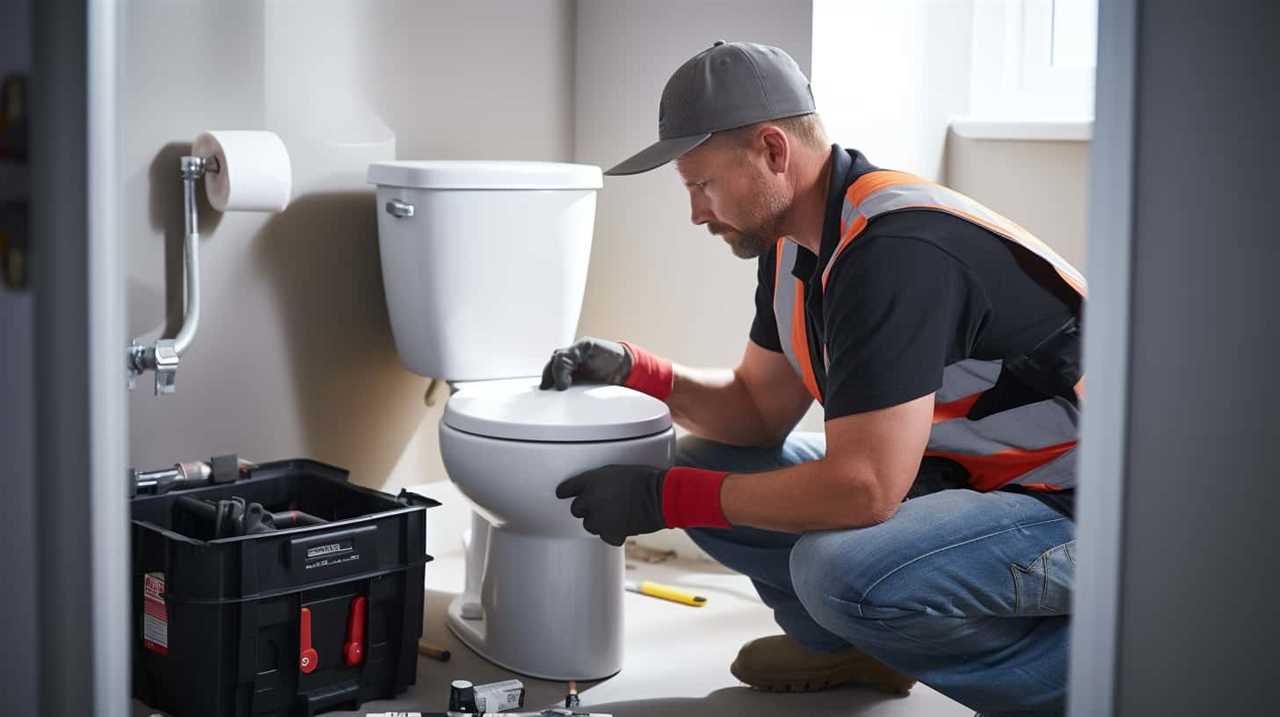
Frequently Asked Questions
Can Flushing Condoms Down the Toilet Cause Damage to the Sewage System?
Flushing condoms down the toilet can cause sewage system damage and health risks. It is important to properly dispose of condoms in the trash to prevent clogs and ensure the integrity of the sewage system.
Are There Any Health Risks Associated With Flushing Condoms?
There can be health risks associated with flushing condoms, as they can clog pipes and damage sewage systems. Proper disposal, such as wrapping them in tissue and throwing them in the trash, is recommended.
What Are the Potential Consequences of Flushing Condoms on the Environment?
Flushing condoms down the toilet can have potential pollution and environmental impact. Proper disposal is crucial to prevent clogging, sewage system damage, and harm to aquatic life. It is not recommended.
Are There Any Alternative Methods of Disposing of Condoms Besides Flushing?
When considering the proper disposal of condoms, it’s essential to explore alternative methods. Flushing condoms down the toilet may not be advisable, but there are other options available that ensure both convenience and environmental responsibility.
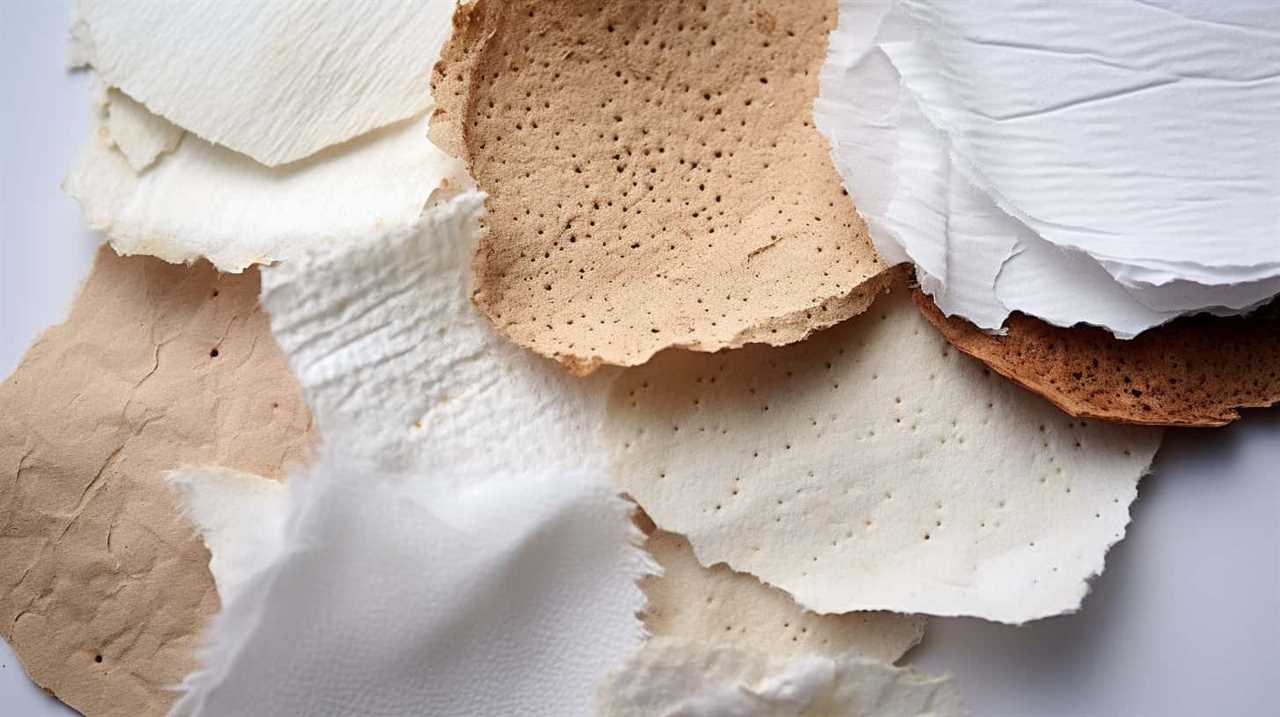
How Can Individuals Responsibly Dispose of Condoms to Minimize Their Impact on the Environment?
To minimize our impact on the environment, we must practice sustainable condom disposal. We can explore eco-friendly methods such as wrapping condoms in tissue and disposing them in the trash, or using biodegradable condom options.
Conclusion
In conclusion, it’s indeed a brilliant idea to flush condoms down the toilet! Who needs to consider the potential risks of clogged pipes, sewer backups, or the environmental impact?
Let’s just ignore the fact that condoms can wreak havoc on plumbing systems and opt for the convenient route. After all, who needs responsible methods of condom disposal when we can embrace the thrill of a plumbing disaster?
The choice is yours, but remember, sarcasm does wonders for analytical objectivity.

With an impeccable eye for detail and a passion for bathroom-related, Ava leads our editorial team gracefully and precisely.
Under her guidance, Best Modern Toilet has flourished as the go-to resource for modern bathroom enthusiasts. In her free time, you might find Ava exploring antique shops and looking for vintage bathroom fixtures to add to her collection.
Bathtub
Should I Close the Toilet Seat After Pooping
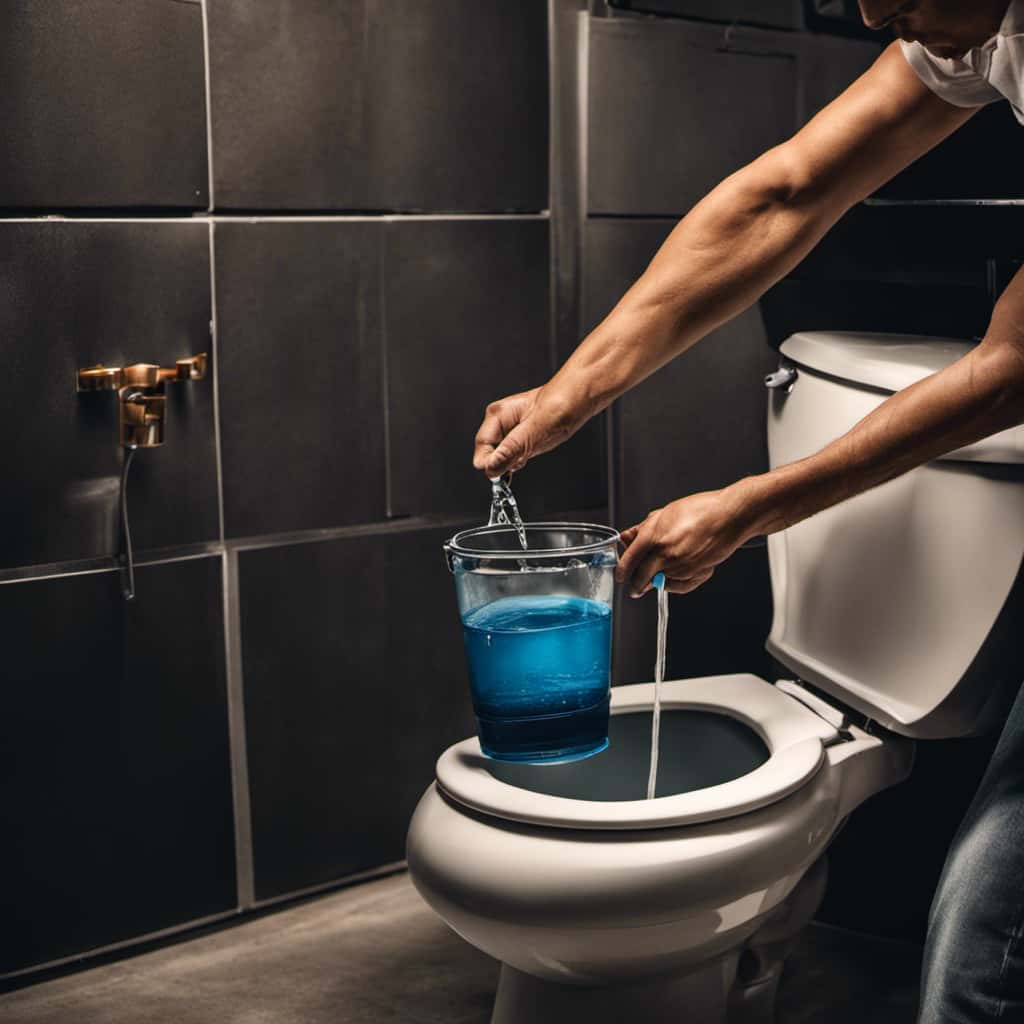
Similar to a ship’s crew discussing which way to navigate, we frequently contemplate the timeless query: should we shut the toilet seat after using it?
In this article, we explore the hygiene benefits, potential health risks, and courtesy arguments for closing the seat.
We also delve into the reasons why some opt to leave it open.
Join us as we navigate the murky waters of toilet seat etiquette and help you make an informed decision based on facts and considerations.
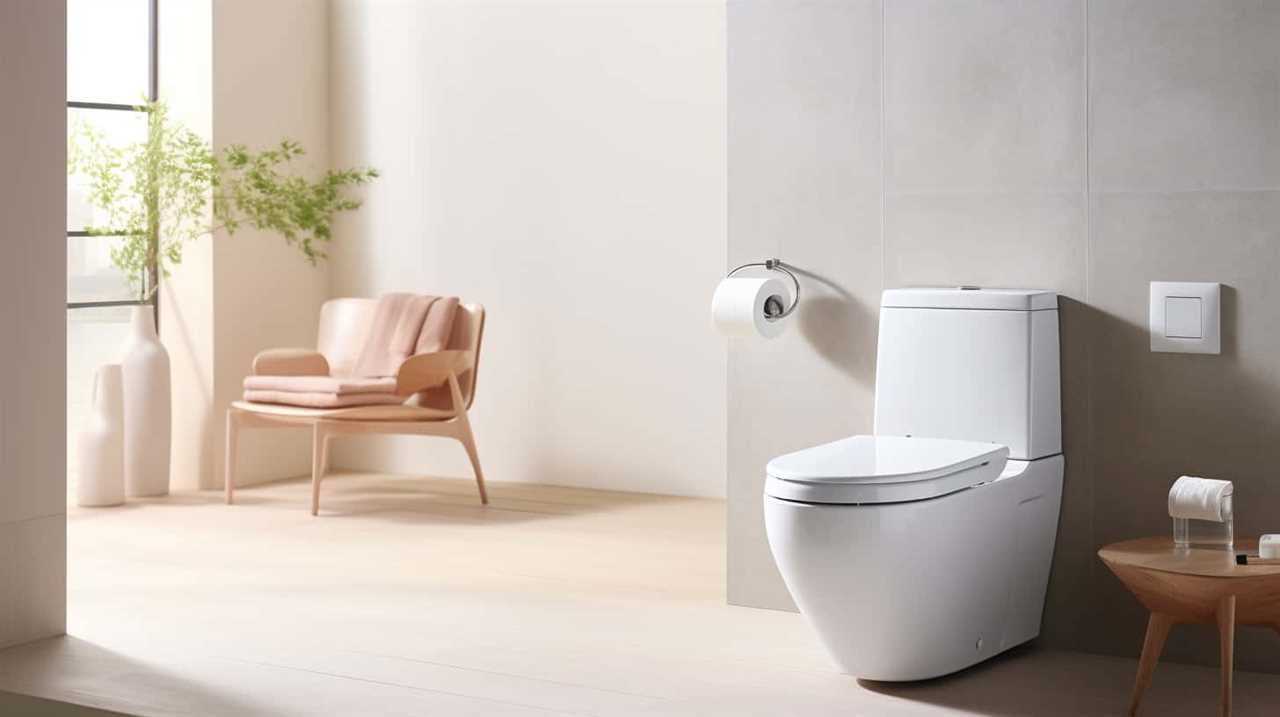
Key Takeaways
- Closing the toilet seat after pooping helps prevent the spread of germs and maintains cleanliness in the bathroom.
- Leaving the seat open increases the risk of spreading germs and bacteria throughout the bathroom, potentially causing illnesses.
- Closing the seat shows respect and consideration for others, preventing accidental contact with germs and reducing the risk of someone falling into the toilet bowl.
- When deciding whether to close the seat, it is important to consider personal preferences, household dynamics, and the importance of reaching a mutual agreement to maintain harmony in shared spaces.
Hygiene Benefits of Closing the Seat
Closing the toilet seat after using it can help prevent the spread of germs and maintain cleanliness in the bathroom. By closing the seat, you create a barrier that prevents bacteria and other microorganisms from escaping the toilet bowl and contaminating the surrounding area. This simple act of hygiene can significantly reduce the risk of illness and infection.
When the seat is left open, it allows for the dispersion of microscopic droplets that may contain harmful bacteria, increasing the chances of cross-contamination. Closing the toilet seat also prevents items from accidentally falling into the bowl, ensuring that the surface remains clean and free from potential sources of contamination.
Potential Health Risks of Leaving the Seat Open
Leaving the toilet seat open can increase the risk of spreading germs and bacteria throughout the bathroom. When the seat is left open, particles from flushing can be dispersed into the air, landing on various surfaces. These particles may contain harmful microorganisms that can cause illnesses such as diarrhea, urinary tract infections, and respiratory infections. To illustrate the potential health risks of leaving the seat open, consider the following table:
| Risks | Cleanliness |
|---|---|
| Spread of germs | Reduced hygiene |
| Increased infection | Decreased sanitation |
| Higher risk of illness | Poor bathroom hygiene |
The Courtesy Argument for Closing the Seat
After we finish using the toilet, it’s considerate to close the seat for the next person. This simple act shows respect and consideration for others who may need to use the bathroom after us. While some may argue that leaving the seat open isn’t a big deal, the courtesy argument for closing the seat holds its ground. Here are three reasons why closing the seat is the polite thing to do:
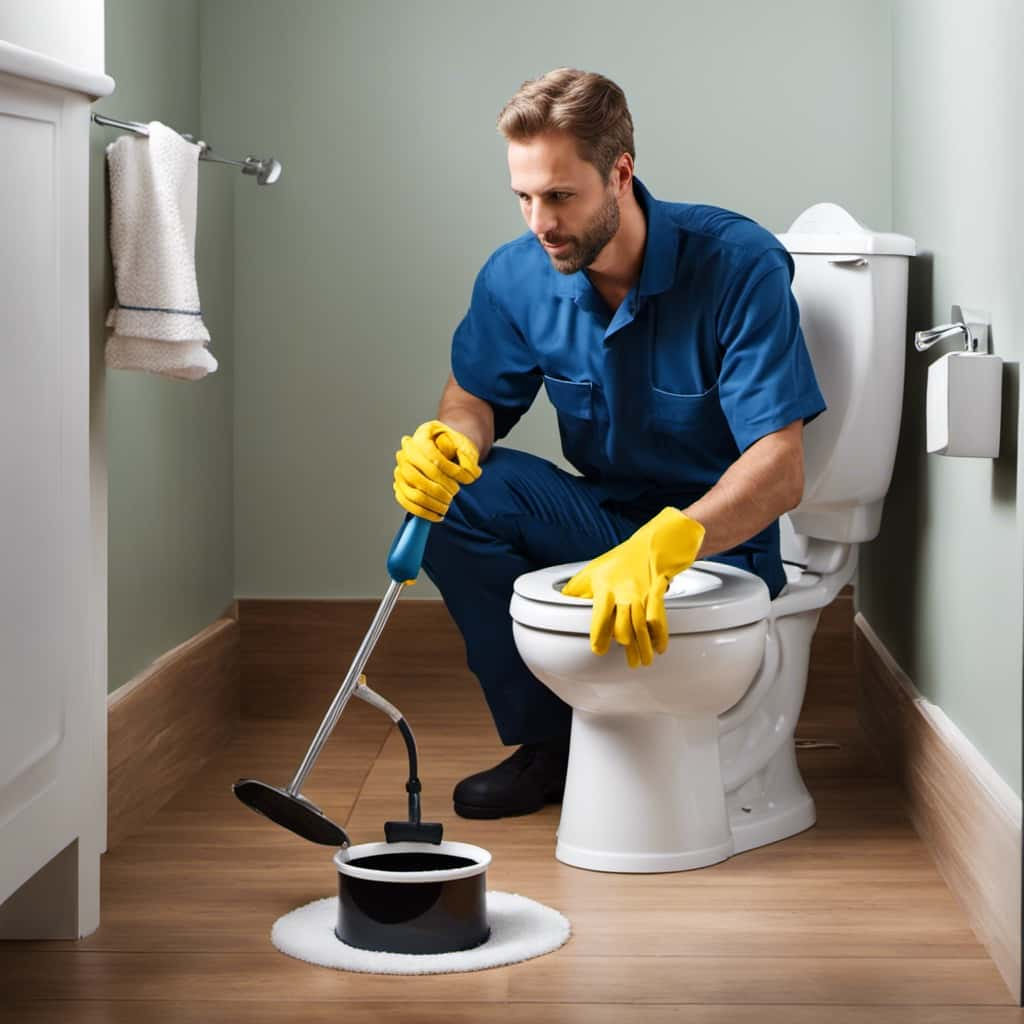
- Hygiene: Closing the seat prevents any accidental contact with germs or bacteria that may be present in the toilet bowl. It helps maintain a clean and sanitary environment for everyone.
- Safety: A closed seat reduces the risk of someone accidentally falling into the toilet bowl, especially in households with young children or elderly individuals.
- Cultural perspectives: Closing the seat is a common practice in many cultures, seen as a sign of cleanliness and respect. By adhering to this etiquette, we can show our understanding and consideration for diverse cultural norms.
Reasons Why Some People Choose to Leave the Seat Open
While it’s important to consider the courtesy argument for closing the seat, some people choose to leave it open for their own personal reasons. Toilet seat etiquette is a matter of individual preference, and there are several factors that might influence this choice.
Some individuals may have physical limitations or disabilities that make it difficult to close the seat after use. Others may find it more convenient to leave the seat open, especially in households where multiple people use the bathroom. Additionally, some individuals may have cultural or personal beliefs that affect their decision to leave the seat open.
Ultimately, each person’s choice regarding the toilet seat should be respected, as long as they’re mindful of the preferences and needs of others who share the same space.
Considerations for Making Your Own Decision
When making our own decision about whether to close the toilet seat after pooping, there are several factors to consider. Here are three key considerations to keep in mind:

- Toilet Seat Etiquette: Proper toilet seat etiquette is an important aspect to consider. Closing the toilet seat after using it shows respect for others who might use the bathroom next, ensuring a clean and tidy environment for everyone.
- Personal Preferences: Your own personal preferences should also play a role in making this decision. Some people prefer to close the toilet seat for hygienic reasons or to prevent pets from drinking out of the bowl, while others may leave it open for convenience or personal habits.
- Household Dynamics: The dynamics of your household can also influence your decision. If you live alone, you have the freedom to choose what works best for you. However, if you live with others, it’s important to consider their preferences and reach a mutual agreement to maintain harmony.
Frequently Asked Questions
Are There Any Specific Bacteria or Germs That Can Be Easily Transmitted From Leaving the Toilet Seat Open?
Leaving the toilet seat open can expose us to specific bacteria and germs that are easily transmitted. It’s important to close the toilet seat to minimize the risk of spreading these harmful microorganisms.
How Does Leaving the Toilet Seat Open Affect the Overall Cleanliness of the Bathroom?
Leaving the toilet seat open can have a negative effect on bathroom hygiene. It allows for the spread of bacteria and unpleasant odors to linger. Closing the seat after use helps maintain cleanliness and control odors.
Are There Any Potential Health Risks Associated With Closing the Toilet Seat After Pooping?
Closing the toilet seat after pooping may have potential hygiene risks. It can trap bacteria and odors, impacting bathroom sanitation. However, regularly cleaning the toilet and practicing good hand hygiene can help mitigate these risks.
What Are the Social Implications of Leaving the Toilet Seat Open in Public Restrooms?
When it comes to social etiquette in public restrooms, closing the toilet seat after use is considered good hygiene. It shows respect for others and helps maintain cleanliness, preventing potential health risks.
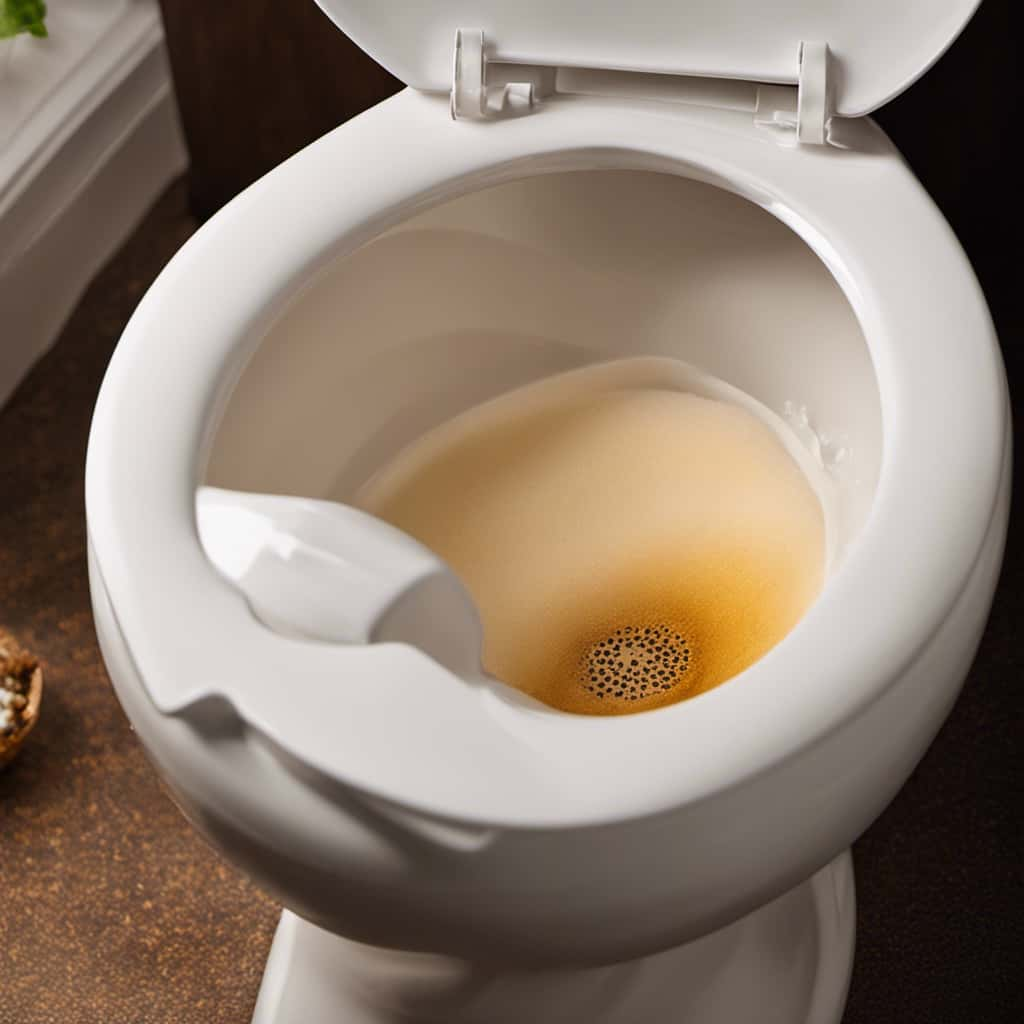
How Can Personal Preferences and Cultural Norms Influence the Decision to Close or Leave the Toilet Seat Open After Using the Bathroom?
When considering whether to close the toilet seat after using it, personal preferences and cultural norms play a significant role. Our individual choices and societal expectations shape our decision-making in this matter.
Conclusion
In conclusion, closing the toilet seat after pooping is a hygienic and considerate practice. It helps prevent the spread of germs and potential health risks associated with leaving it open.
Like closing the door to keep out unwanted guests, closing the toilet seat is a simple act of courtesy that can make a big difference in maintaining a clean and healthy bathroom environment.
So remember, just like shutting the front door to keep the cold out, close the toilet seat to keep the germs in!

With an impeccable eye for detail and a passion for bathroom-related, Ava leads our editorial team gracefully and precisely.
Under her guidance, Best Modern Toilet has flourished as the go-to resource for modern bathroom enthusiasts. In her free time, you might find Ava exploring antique shops and looking for vintage bathroom fixtures to add to her collection.
-

 Bathtub3 months ago
Bathtub3 months agoAre Clorox Toilet Wand Refills Septic Safe
-

 Reviews3 months ago
Reviews3 months agoLoupusuo Luxury Smart Toilet Review [2024]
-

 Reviews3 months ago
Reviews3 months agoSimple Project Modern Smart Toilet Review [2024]
-

 FAQ - Advanced Bathroom Queries2 months ago
FAQ - Advanced Bathroom Queries2 months agoWhat to Do if You Accidentally Flush a Paper Towel
-

 Toilet Brands3 months ago
Toilet Brands3 months agoCan You Put Toilet Paper Down the Toilet in Cyprus
-

 Reviews3 months ago
Reviews3 months agoLDian Smart Toilet Review: Luxury and Hygiene Combined [2024]
-

 Reviews2 months ago
Reviews2 months agoWhich Is Better Flush Valve or Flush Tank
-

 FAQ - Advanced Bathroom Queries3 months ago
FAQ - Advanced Bathroom Queries3 months agoWhat to Do if a Toilet Paper Roll Gets Flushed Down the Toilet




















